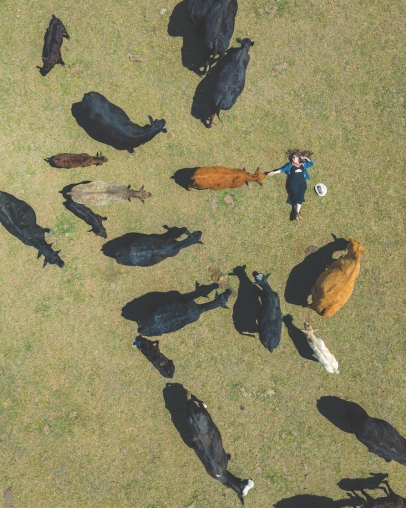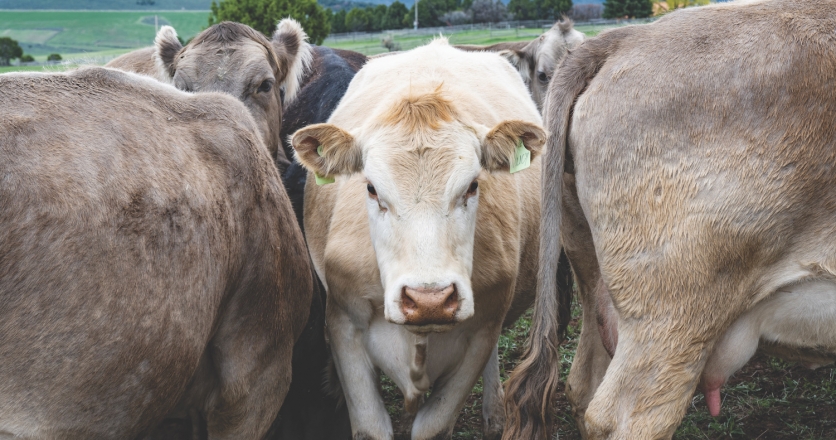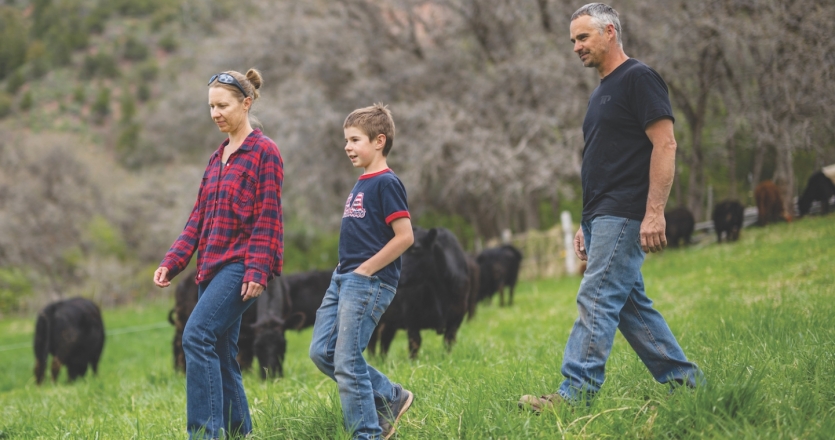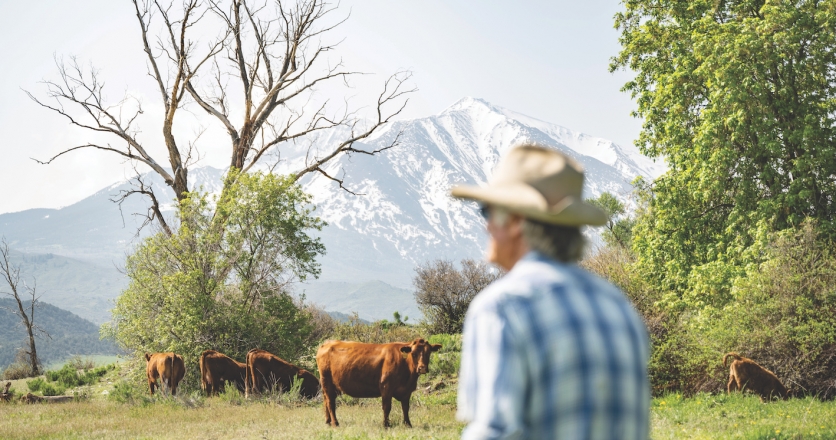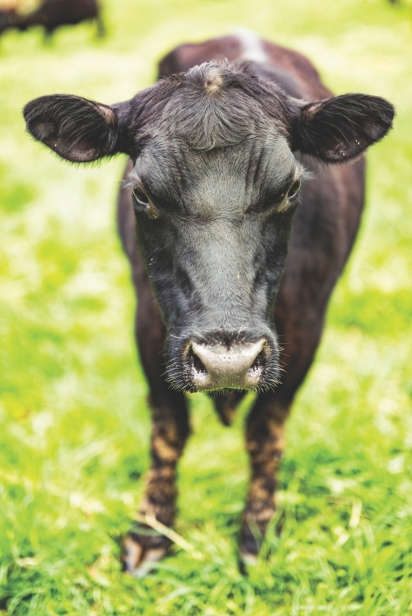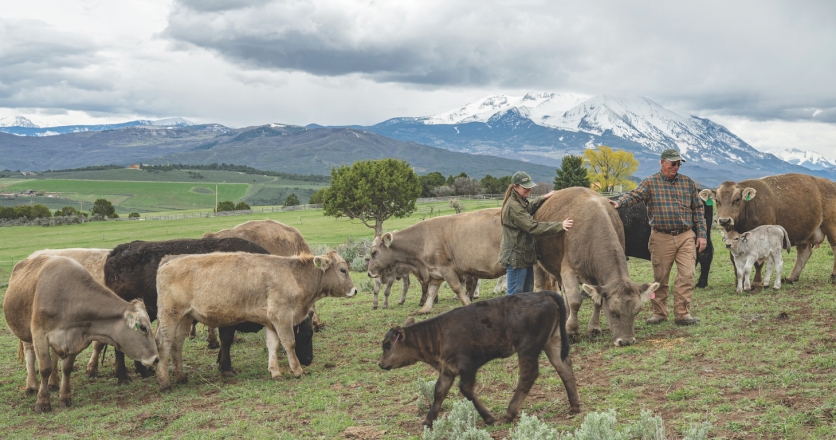‘More Than Just a Job’
With their connections to land and seasons, five generations of ranchers have helped steward the Roaring Fork Valley ecosystems within which they’ve raised their animals. Today’s ranchers, however, are experiencing radical impacts to their ever-evolving way of life. Climate change, scrutiny of industrial beef practices, demographic shifts in mountain towns, economics, and a near-monopoly held by the “big four” meat processors have ranchers wearing more hats than their Stetsons. And yet, they’re still getting after it. Why?
Because there’s no other life they want.
“It’s two full-time jobs, but it’s more than just a job,” says fourth-generation rancher Ashley Jammaron. “Ranching is our way of life.”
Every morning, before her desk job, Jammaron coordinates chores with her uncle Ken or dad, Glen, on the family ranch between Glenwood Springs and Carbondale. “Being outside every day, being with the animals, it’s a lot of work—and it’s empowering.”
Empowering enough to tackle some hefty challenges outside of their job descriptions? Here’s how local ranchers are wrangling them.
A course change amid climate change
What and how ranchers produce can contribute to climate change or help abate it.
When fifth-generation rancher and businessman Jared Kerst sold his landscape supply business, Rivendell, in 2021, it was a deliberate move toward a life he wanted to live—meaningful, physical, outdoors. With a purpose-before-profit ethos, Kerst now “renourishes” his land in Spring Valley every day, land he hopes to pass along to his daughters.
“Everything about sod is extractive. We took and we took and we took,” he says. “So, I’ve abandoned my nest egg in pursuit of this beef thing, and the soil thing.”
Both sets of Kerst’s grandparents had owned feedlots, but Kerst chooses to invest in the ancient relationship between grasslands and ruminants. He studies regenerative ranching theory and operates from the heart. He farms a fraction of the sod he used to—until he won’t have to—to finance raising regenerative, grass-finished beef.
“My hope is to turn this to ‘bacon,’” he jokes, “and at least a living wage.” Until that point, Kerst measures his net worth in the microbial-fungal relationships between his cattle, the pastoral fecundity that feeds them, and the gut biome and health of the customers who purchase his Plus Lazy K beef.
“You can taste all this in the meat,” he said last summer, sweeping his arm to rotating paddocks of standing forage and the peaceful cattle around him.
Ranching under pressure
Pressure on the beef industry from animal rights activists and environmentalists has changed the way ranchers perceive livestock and provide for their animals’ needs.
When Mollie and Jake Shipman returned to her family’s fourth-generation land on Dooley Creek in the Crystal River Valley, they knew the issue that earned ranching a bad reputation was “the how, not the cow.” Besides cattle, they raise pigs, chickens, and turkeys on their regenerative farm named for the creek that runs through it. It’s hands on, every day. Chicken tractors and a handcrafted mobile coop move across healthy pastures. You can hear contented coos and babbling as birds forage, hunt bugs, and feed droppings back to the soil—a genuinely idyllic cycle.
“‘Management by abandonment’ hasn’t proven effective,” says Mollie Shipman of contemporary large land ownership, in which acreages aren’t managed optimally. “We need animals on the land for it to thrive. There’s great promise in holistically managed ranching to restore our grasslands.”
But Dooley Creek Farm’s 25 acres of pasture and 30 acres of oak brush aren’t enough to run its 40 head of cattle. “Even with maximized forage utilization paired with management-intensive grazing, we need more grass,” Shipman says.
Justina and Ted Potter face the same constraints with Potter Farms on Missouri Heights. “We need local space in our community for grazing and making hay,” Justina Potter says, “so we’re not moving our animals, equipment, or operations far distances.”
Rather than overgraze, these ranchers rely on leases. Traditionally, local ranchers hold grazing permits on BLM or national forest land. The Shipmans and Potters lease land from local landowners who don’t farm or ranch, but enjoy the bucolic presence of farm animals. Suitable acreages can have mixed ecosystems of shrub-grassland, forest, or even just pasture. In return, their land is reinvigorated.
Evolving over millennia, grasslands flourish through periodic disruption—be it grazing or fire—or they decline. Western monocultures of smooth brome or crested wheatgrass exemplify this. Holistic grazing revitalizes ecosystems. Animal and insect wastes increase soil organic matter and nourish the food web. Hooves chop and scatter biomass, work grass and forb seeds into the soil, and create mini water-holding pockets. Healthy shoots and roots slow runoff and erosion. Grazed openings encourage additional species to flourish. Resultant biological diversity improves ecological services to planetary systems necessary for life.
“It’s a win-win,” says Shipman. In the race against rising temperatures and land degradation, ranchers across the West now charge landowners for valuable land management expertise and the imperative ecological services their cattle provide.
Collaboration and adaptation
Bill Fales and his wife, Marj Perry, run a cow-calf operation with their two daughters, Katy and Molly. Expansively breathtaking, Cold Mountain Ranch is a bucolic gateway to Carbondale along Highway 133 and has been in Perry’s family since 1941.
Fales and Perry also have grazing permits in the White River National Forest. In the spring and fall, they run their cattle through town, a celebrated parade in Carbondale culture. Their bull pasture is on Pitkin County Open Space. And for 30 years, Fales grazed his cattle on Coffman Ranch, now under conservation with Aspen Valley Land Trust.
When a feisty cow shattered Fales’s pelvis last summer, he passed his grazing lease at Coffman to longtime local ranchers Tai and Molly Jacober, who currently don’t own grazing lands in the valley. Partnering on various aspects of ranching together, both operations control more of the return on their investments.
Brian Hightower, who is relatively new to his role managing Coffman Ranch for AVLT, values the depth of their ranching expertise as he steers the ranch toward an experiential learning asset for the community at large.
“Tai, like Fales, shares our philosophy that a healthy agri-ecosystem starts with the soil,” wrote Hightower in an email conversation. “In our first year, we’ve weaned the pastures from synthetic fertilizers and have suspended cutting hay in favor of planned grazing. Despite the potential for a short-term decline in production from these changes, Tai shares the long view of increasing the diversity of both our soil microbiome and the plant matter above ground. Both have been great mentors as AVLT begins its new chapter as a [conservation] ranch owner.”
Cold Mountain Ranch is fully conserved, too, and as such is obligated to use best management practices. A few years ago, Fales began subdividing the bull pasture. In grazing and resting each paddock, as he does at Cold Mountain, Fales has seen noticeable improvement. And contrary to what the public might think, “we’ve been doing a rest-rotation on the forest [leases in Coal Basin and Thompson Divide] forever. We have so many miles of fence,” he sighs, referencing barbed-wire fencing used to control grazing.
Fales and Jacober are looking at virtual fencing, which works similarly to invisible fencing for dogs. Through GPS and electric cattle collars, ranchers can move the electric perimeter through control towers. This perimeter can bunch cattle more tightly where the landscape needs to be grazed and regenerated. Ranchers can protect sensitive streambeds and endangered plants, and preserve winter wildlife habitat, all from a smartphone.
But at a high price: The size and topography of their grazing permit requires five towers with cell service at about $10,000 per tower. In addition, each season ranchers must lease electric collars for every animal. Because virtual fence systems are expensive, Fales and Jacober are looking at grants with the Forest Service or Colorado Parks and Wildlife’s Habitat Partnership Program.
Money isn’t the only hurdle they and other ranchers face. “Recreation is so dominant,” says Fales, noting how rapidly it has impacted wildlife and ranching. In the last two or three years, hiking, mountain biking, dogs, and other uses have increased in the Thompson Divide. That pressure has pushed ungulate herds onto Cold Mountain pastures almost year-round. In the winter, wildlife herds also feed farther south, roaming onto nonprofit Sustainable Settings’s land. Both ranches lose forage to wildlife, but their owners recognize they’re providing critical habitat to wildlife.
Sitting at his dining room table, Fales points to views of the Crown through the kitchen window. “The Nieslaniks run cattle on the Crown,” Fales says of a near-lifelong peer. “The bicycles have pushed everything—wildlife and cattle. They literally made a bike jump out of a stock watering tank. It makes it really hard. It’s just not compatible.”
“It is hard to operate when they’re up there,” confirms Marty Nieslanik. “You have five bikes coming down a trail where cattle are grazing. Those bikes don’t stop. It scatters the animals, stresses them.”
A fourth-generation rancher, Nieslanik and his wife, Jerilyn, ranch the land his dad, John, bought in the late 1950s: 166 acres on East Mesa between Carbondale’s Main Street, the historic cemetery, and the Crown, spilling from the flanks of Mount Sopris. His grandfather ran cattle in Spring Valley. You can dine on the family’s beef at the Brass Anvil, Peppino’s Pizza, Dos Gringos, Beer Works, and several Aspen Skiing Co. eateries.
The ‘big four’ versus local needs
Since the 1980s, mergers in the industry have led to four corporations controlling 80 percent of the feedlot beef industry. Not only do they slaughter, but they have also taken on cut-and-wrap butchering and packaging meat and meat products.
Processors used to be located near farms and ranches. The Nieslaniks haul their cattle to a small processor in Craig at least once a month, with seven or eight runs around the holidays. The carbon footprint, time burned in transport, and money invested outside of the community hurts not only the ranchers, but the community.
“We have to drive two hours to get our cattle processed,” Mollie Shipman says. “Transporting so far isn’t ideal for the animals and it’s a huge cost, driving to and from Montrose every few weeks, year-round, to deliver animals and pick up meat.”
After so much effort to raise clean, grass-finished beef, Kerst white-knuckled his first grass-finished cattle to a Montrose processor during a snowstorm. He had no choice. Small ranchers are forced to reserve their time slot months in advance—not even knowing for certain what they’ll need or have, or if it’ll be market size.
“I was so worried it would ruin the flavor,” he says. He immediately prepared a standing rib roast for his family before selling any. Luckily, “It was exquisite!”
The massive expansion in meat factories concentrates workers. During the pandemic, COVID outbreaks slowed or closed meat factories, causing product backups, empty store shelves, and a live animal surplus, further dropping the value of beef. Ranchers with already-butchered meat and onsite freezer storage demonstrated the resilience and importance of smaller providers freed from agribusiness models.
“There’s a need for hyper-local abattoirs,” says Shipman, referring to slaughter and meat-processing facilities. “There’s been a renaissance in artisanal butchery sweeping across the country and we feel that there is a gap here, locally, that an enterprising individual or business could fill.”
“A processing warehouse has to be near town, but you can’t do that anymore. What if we could have mobile abattoirs on ranches?” Kerst asks. “I envision modular slaughter locations strategically placed around the region, with processing and packaging aggregated in one central commercial location.”
USDA-certified mobile slaughter and processing is proving successful around the nation, and cooperative ownership by ranchers and investors has many benefits: It’s more humane for animals. It preserves local terroir, producing rich, full flavor and texture. Ranchers can offer epicurean delights such as the head, cheeks, offal, and bones. Ranchers can produce under their brand, and profits are reinvested within the cooperative, not lost to outside commercial operations.
A watershed moment with much at ‘steak’
Some ranchers feel local processing is possible and imperative. Other ranchers feel that without the participation of larger ranches, the carrying capacity doesn’t exist.
At the time of this writing, it was calving season in the Roaring Fork Valley—a time of year when ranchers shine most from under
the brims of their many hats.
“We pulled a calf at 3 a.m. and were back up at 7, bottle-feeding calves this morning,” one patient ranch manager shared in a brief call. “We have about 400 moms and 800 heartbeats.” In addition to raising cattle, this rancher is a wildlife biologist, intensely connected to land and partnering with many organizations to better understand and preserve the ranching-wildlife interface.
The pressures on ranching are intense, the margins small, especially as the Roaring Fork Valley adapts to demands for more: more housing, more access, more trails, more choices. Ranchers emphasize the need for more, too: more community support, more tolerance, more large animal services and ag supplies—and a new ethos and economy in artisanal meat processing.
Holistic grazing and modern ranchers hold the key to landscape-scale revitalization and clean, delicious meat. Some believe that given the trifecta of quality water, quality soils, and diverse landscapes, bolstered by the valley’s socio-financial resources, making a regional watershed-wide beef brand is possible. So, here we stand, at the threshold of an untapped, exciting entrepreneurial opportunity. Will the Roaring Fork Valley take the next step? ❧


